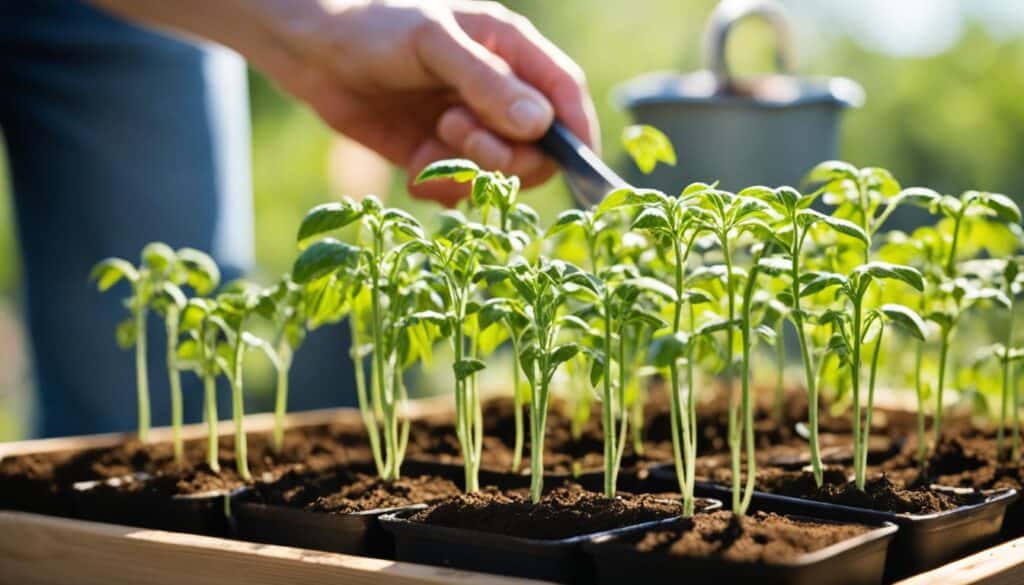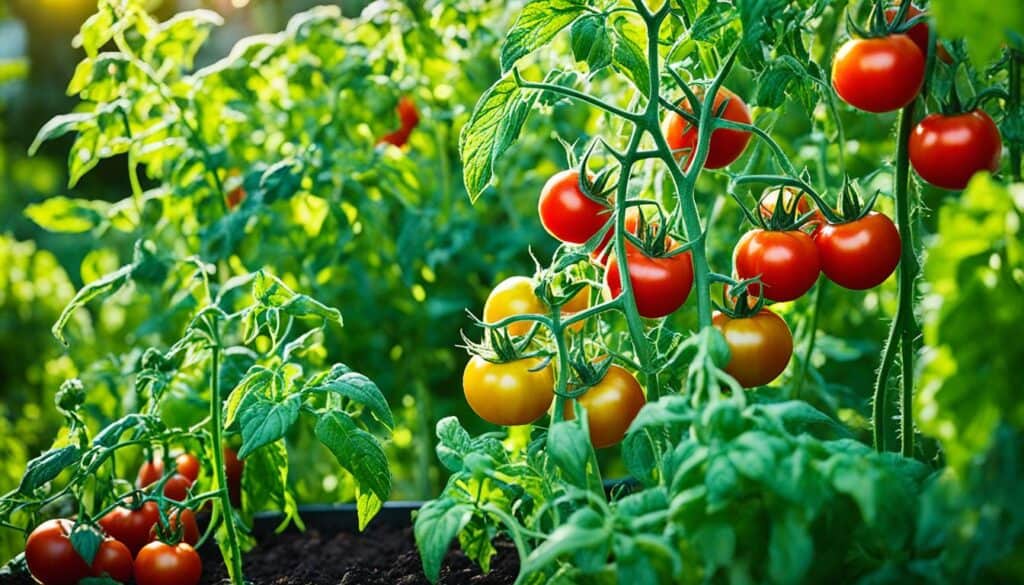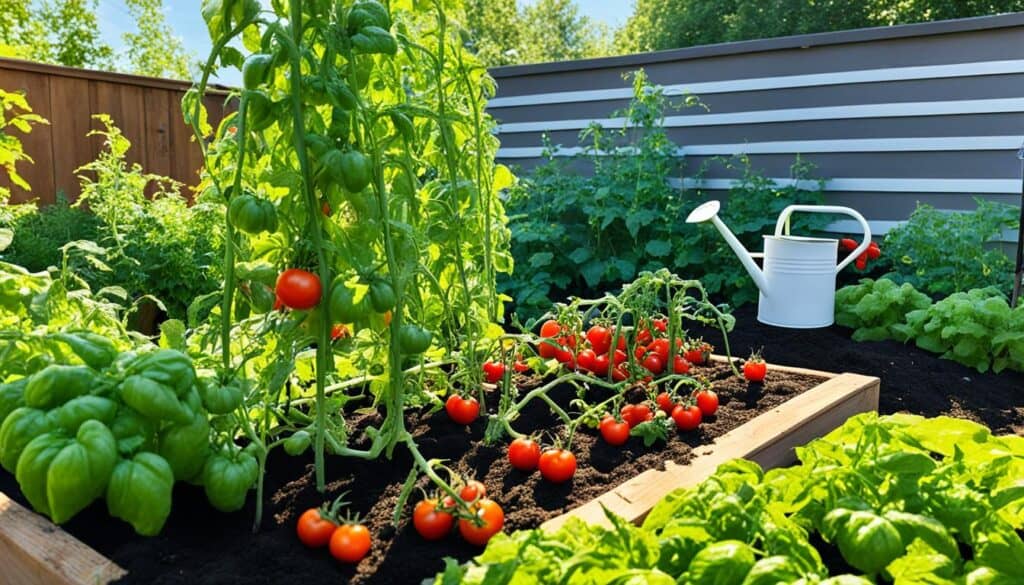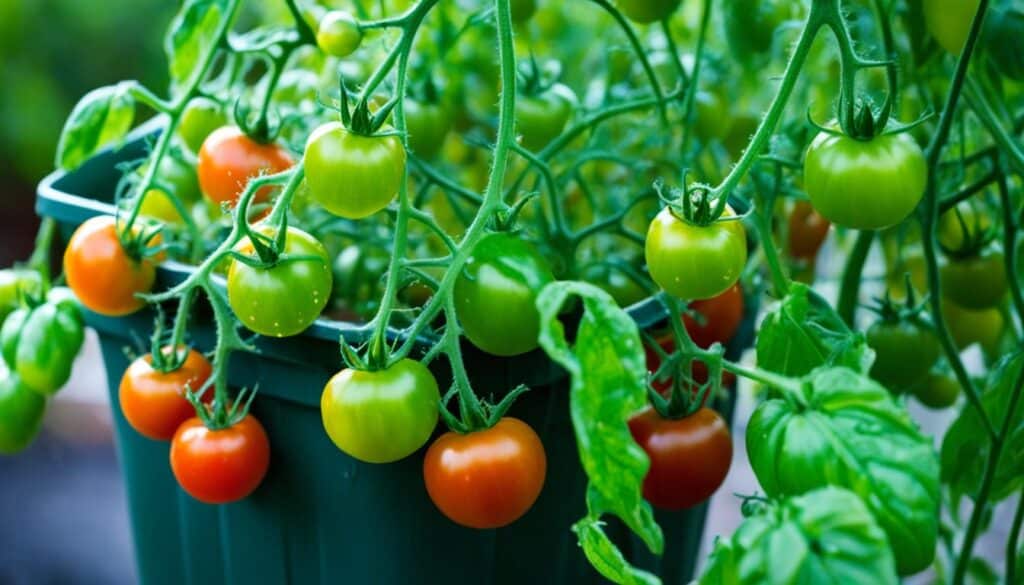Did you know that Rutgers tomatoes, with their delectable flavor and rich history, are a favorite among tomato enthusiasts? These unique tomatoes, known for their bright red color and delightful taste, are a must-have in any garden. In this article, I will share valuable tips and guidelines for successfully growing and enjoying the bountiful harvest of Rutgers tomatoes in your own backyard. Get ready to elevate your gardening game and experience the true joy of homegrown tomatoes!
Key Takeaways:
- Learn how to choose the perfect seeds or seedlings for your Rutgers tomatoes
- Discover the ideal growing conditions that will ensure a thriving tomato plant
- Master the art of transplanting your Rutgers tomato seedlings for optimal growth
- Understand the importance of spacing and companion planting for successful tomato cultivation
- Get expert tips on mulching, staking, and pruning your Rutgers tomato plants
Choosing Seeds or Seedlings for Rutgers Tomatoes
When growing Rutgers tomatoes, you have the option of starting from seeds or purchasing seedlings. Both methods have their advantages and considerations, so let’s explore the pros and cons of each.
Starting from Seeds
If you choose to start from seeds, it allows you to have a wider variety of Rutgers tomato options. You can select from different seed vendors or even save seeds from your own harvest. Starting from seeds also gives you more control over the growing process, as you can ensure the seeds are planted in optimal conditions.
To start from seeds, sow them in well-drained soilless starting mix about 6 weeks before the anticipated transplanting date. Rutgers tomatoes prefer warm soil between 65-90°F for germination. Soaking the seeds overnight before planting can also help improve germination rates.
Tip: Label your seed trays or pots to keep track of the tomato variety.
Keep the seedlings in a warm, well-lit area until they develop their first true leaves. At this stage, thin out the weaker seedlings, leaving only the healthiest ones to grow stronger.
Purchasing Seedlings
If you prefer to skip the seed-starting process, you can purchase Rutgers tomato seedlings from nurseries or garden centers. This option offers convenience and saves time, especially if you have limited space or are starting your garden later in the season.
When selecting seedlings, look for sturdy, dark green plants that appear healthy and vibrant. Avoid tall or leggy plants, as they may not perform as well after transplanting. Inspect the leaves for any signs of discoloration or pests.
Quote: “Choosing healthy seedlings is key to a successful garden.” – Gardening Expert
Ensure your purchased seedlings are gradually acclimated to outdoor conditions before transplanting them into the garden. This process, known as hardening off, helps prevent transplant shock and allows the plants to adjust to changes in temperature and sunlight.
| Starting from Seeds | Purchasing Seedlings |
|---|---|
| More variety options | Saves time and effort |
| Requires seed starting supplies | Can’t guarantee seed source |
| Full control over the growing process | May have limited availability |
Ultimately, whether you choose to start from seeds or purchase seedlings, the key is to provide your Rutgers tomatoes with the right growing conditions and care to ensure a successful harvest.
Ideal Growing Conditions for Rutgers Tomatoes
Rutgers tomatoes thrive in warm and hot growing conditions, making them a perfect addition to your sunny garden. To ensure optimal growth and a bountiful harvest of delicious tomatoes, it’s important to provide them with the ideal growing conditions. Here are some tips and guidelines:
Sunlight
Rutgers tomatoes require at least 6 hours of direct sunlight every day. Choose a sunny location in your garden where the plants can receive ample sun exposure. This will help them grow vigorously and produce flavorful fruits.
Soil
The soil you plant your Rutgers tomatoes in should be well-drained and fertile, with a high content of organic matter. These tomatoes prefer slightly acidic soil with a pH range of 6.0 to 6.8. You can test the soil pH using a home testing kit or by sending a sample to a local gardening center for analysis. Adjust the pH if necessary to provide the ideal conditions for your plants.
Spacing
Proper spacing is essential for the healthy growth of Rutgers tomatoes. Depending on the variety, the plants should be spaced 12-36 inches apart. Providing adequate spacing allows each plant to have enough room to grow and ensures good air circulation, reducing the risk of diseases.
Fertilization
Rutgers tomatoes are heavy feeders and require regular fertilization. Use a fertilizer blend that is rich in phosphorus and potassium, two essential nutrients for healthy plant growth and fruit development. Apply the fertilizer according to the manufacturer’s instructions, and make sure to water the plants immediately after fertilizing to prevent any potential burning.
By providing your Rutgers tomatoes with the ideal growing conditions, you’ll set them up for success and ensure a season full of abundant, delicious tomatoes.
| Growing Conditions | Requirements |
|---|---|
| Sunlight | At least 6 hours of direct sunlight daily |
| Soil | Well-drained, fertile soil with high organic matter content; slightly acidic pH of 6.0-6.8 |
| Spacing | 12-36 inches apart, depending on the variety |
| Fertilization | A blend rich in phosphorus and potassium |
Transplanting Rutgers Tomato Seedlings
Once the last frost has passed and temperatures remain above 50°F at night, it’s time to transplant your Rutgers tomato seedlings. To ensure successful transplantation, follow these helpful tips:
- Choose sturdy, dark green seedlings that have not started flowering yet. These plants are likely to establish well in the garden.
- Harden off the seedlings by gradually reducing water and fertilizer over the course of a week. This process acclimates them to the outdoor environment and minimizes transplant shock.
- Prepare the planting area by removing any weeds and loosening the soil.
- Bury the tomato plants. Dig a hole deep enough to bury the stems so that the soil level is just below the lowest leaves. This helps promote a stronger root system, enhancing the plant’s overall growth and stability.
- Space the seedlings according to the recommended distance, typically 12-36 inches apart depending on the variety. This allows ample room for the plants to grow and ensures proper airflow, which reduces the risk of diseases.
- Water the transplanted seedlings thoroughly, providing enough moisture to settle the soil around the roots.
By transplanting your Rutgers tomato seedlings using these techniques, you can give them the best start in your garden, setting the stage for a successful harvest.
Spacing and Companion Planting for Rutgers Tomatoes
Proper spacing is crucial for the healthy growth of Rutgers tomatoes. Depending on the variety, you need to ensure the right amount of space between each plant to allow for optimal development. Here are the recommended spacing guidelines:
- Determinate varieties: These compact plants should be spaced 12-24 inches apart. This spacing allows them to grow upright and produce an abundant harvest.
- Staked indeterminate varieties: For indeterminate varieties that you plan to stake, aim for a spacing of 14-20 inches between each plant. The staking helps promote upward growth and makes it easier to manage the plants.
- Unstaked indeterminate varieties: If you choose not to stake your indeterminate Rutgers tomatoes, give them more room to spread out. Space them 24-36 inches apart to allow for their sprawling growth habit.
In addition to proper spacing, companion planting can also benefit your Rutgers tomatoes. Certain plants can be grown alongside tomatoes to enhance their growth and repel pests. Consider planting these compatible companions near your Rutgers tomatoes:
- Carrots: Carrots help improve the soil structure and are believed to enhance tomato flavor.
- Onions: Onions act as natural pest deterrents.
- Chives: Chives repel pests and attract beneficial insects.
- Garlic: Garlic is known for its pest-repelling properties.
- Asparagus: Asparagus acts as a natural fungicide and can help protect tomatoes from diseases.
- Roses: Roses attract pollinators and can help with cross-pollination.
- Nettle: Growing nettle near tomatoes can act as a nutrient accumulator, benefiting the surrounding plants.
However, it’s important to note that not all plants make good companions for tomatoes. Keep your Rutgers tomatoes away from members of the Brassicaceae family (cabbage, broccoli, etc.), corn, potatoes, and fennel herb. These plants can hinder tomato growth or attract pests that can harm your tomatoes.
“Proper spacing and companion planting can help promote the healthy growth of your Rutgers tomatoes.”
Mulching, Staking, and Pruning Rutgers Tomato Plants
When it comes to growing Rutgers tomatoes, mulching, staking, and pruning are essential practices that can greatly enhance the performance of your plants. These techniques not only promote healthier growth but also contribute to earlier harvests, improved fruit quality, easier maintenance, and disease prevention.
One important aspect of tomato care is mulching. Mulching helps retain soil moisture, regulate soil temperature, and suppress weed growth around your Rutgers tomato plants. You can choose to use black plastic mulch or opt for organic mulches such as straw or compost. Apply a layer of mulch around the base of the plants, ensuring that it doesn’t touch the stems directly. This will help conserve moisture, reduce weed competition, and create a healthier growing environment for your tomatoes.
Another technique that can greatly benefit indeterminate Rutgers tomato varieties is staking. Staking provides support for the tall, vining plants and helps prevent them from sprawling on the ground. By keeping the plants upright and off the soil, staking promotes better air circulation, reduces the risk of disease, and makes it easier to harvest ripe tomatoes. You can use wooden stakes or tomato cages to support the plants, ensuring they are firmly anchored into the ground.
Pruning is another practice that can improve the performance of indeterminate Rutgers tomatoes. Pruning involves removing the suckers, which are the new growth that emerges from the leaf axils. By removing these suckers, you redirect the plant’s energy towards fruit production and promote the development of strong, productive branches. Pruning also helps increase airflow around the plants, reducing the risk of fungal diseases. Use clean, sharp pruning shears to cut off the suckers, making clean cuts close to the main stem.
By implementing these mulching, staking, and pruning techniques, you can create optimal growing conditions for your Rutgers tomato plants and maximize their yield. Remember to mulch to conserve moisture and suppress weeds, stake to provide support and improve air circulation, and prune to redirect energy towards fruit production and reduce disease risk.
Watering and Feeding Rutgers Tomato Plants
Proper watering and feeding are essential for the healthy growth and development of Rutgers tomato plants. By providing consistent moisture and a balanced fertilizer blend, you can ensure a thriving garden filled with delicious tomatoes.
Watering Tips
Rutgers tomato plants should be watered moderately, ensuring they receive consistent moisture without overwatering. These deep-rooted plants are drought-tolerant once established, but they still require regular watering, especially when they start flowering and bearing fruit. To water your plants effectively:
- Water the plants at the base, avoiding wetting the foliage to prevent diseases.
- Water deeply, ensuring the moisture penetrates the root zone.
- Water early in the morning to allow leaves to dry, reducing the risk of fungal infections.
- Monitor soil moisture levels and adjust watering frequency based on weather conditions.
Feeding Guidelines
Rutgers tomatoes are heavy feeders and require a diet rich in phosphorus and potassium. While commercial fertilizers can provide the necessary nutrients, organic options like fish emulsion or seaweed extract are recommended for regular feeding. These organic fertilizers not only nourish the plants but also contribute to soil health. When fertilizing your Rutgers tomato plants:
- Apply a balanced fertilizer blend with a higher ratio of phosphorus and potassium.
- Follow the package instructions for application rates and frequency.
- Avoid excessive nitrogen fertilization, as it can promote excessive foliage growth at the expense of fruit production.
- Consider supplementing with additional organic matter, such as compost, to improve soil fertility.
By maintaining proper watering and feeding practices, you can provide your Rutgers tomato plants with the essential resources they need to thrive and yield a plentiful harvest of flavorful tomatoes.
Harvesting and Using Rutgers Tomatoes
After patiently waiting for about 2.5 months, it’s finally time to harvest your bountiful crop of Rutgers tomatoes. These vibrant, bright red tomatoes are the culmination of your hard work and dedication. When the tomatoes reach full maturity, which is indicated by their rich color and slightly flattened shape, it’s time to pick them and savor their incredible flavor.
Once harvested, Rutgers tomatoes can be enjoyed in a variety of ways. Their excellent flavor makes them perfect for slicing and adding to salads, sandwiches, and salsas, where they add a burst of freshness and juiciness. Additionally, these tomatoes can be cooked down to create mouthwatering sauces and soups, infusing your dishes with their robust flavor.
Whether you’re a fan of fresh preparations or prefer to experiment with different recipes, Rutgers tomatoes are sure to elevate your culinary creations. Their versatility and well-balanced taste make them a favorite among gardeners and chefs alike.
Growing Rutgers Tomatoes in Containers
Rutgers tomatoes can be successfully grown in containers, making them a great option for small gardens or those with limited space. I have found that growing Rutgers tomatoes in containers provides me with fresh, homegrown tomatoes even when I don’t have access to a traditional garden plot. With a few key considerations and proper care, you can enjoy a bountiful harvest of these delicious tomatoes right from your patio or balcony.
Choosing the Right Container
When selecting a container for growing Rutgers tomatoes, choose one that is large enough to accommodate the growing plant and has good drainage. A container with a capacity of at least 24-48 inches deep and 18-36 inches in diameter works well. This size allows for adequate root development and ensures that the plant has enough space to thrive.
By providing enough room for the roots to spread out, you can help your Rutgers tomato plant establish a strong foundation for optimum growth and productivity.
Proper Support
Just like their counterparts planted in the ground, Rutgers tomato plants grown in containers also require support as they grow. To keep the vine upright and prevent it from sprawling in all directions, provide sturdy support for the plant. You can use a tomato cage, trellis, or even a stake to keep the plant upright and help it focus its energy on producing quality tomatoes.
Getting Enough Sunlight
Full sunlight is essential for the successful growth of Rutgers tomatoes, even when they are grown in containers. Ensure that the container is placed in a location where it receives at least 6 hours of direct sunlight every day. This will help the plant photosynthesize efficiently and produce flavorful, ripe tomatoes.
Choosing the Right Soil Mix
A fertile soil mix is crucial for container-grown Rutgers tomatoes. Choose a well-draining potting mix that is rich in organic matter. Avoid using garden soil alone, as it may not provide adequate drainage and can lead to waterlogged roots. A quality potting mix specifically formulated for container gardening will provide the necessary nutrients and moisture retention for your Rutgers tomato plant to flourish.
Regular Watering
Container-grown tomatoes may dry out faster than those planted in the ground, so it’s important to water them regularly. Monitor the moisture levels in the soil and water the plant whenever the top inch of soil feels dry to the touch. Avoid overwatering, as it can lead to root rot and other problems. Consistent, moderate watering will help ensure healthy growth and vibrant tomatoes.
Following these growing tips, you can successfully cultivate Rutgers tomatoes in containers and enjoy the rich flavor of these delicious tomatoes, even with limited gardening space.
Common Problems and Pests for Rutgers Tomato Plants
While Rutgers tomatoes are known for their delicious flavor and versatility, they can sometimes be susceptible to various problems and pests. It’s important to be aware of these common issues and take necessary steps to prevent or address them to ensure a successful harvest.
Here are some common problems that Rutgers tomato plants may encounter:
- Blossom end rot: This condition is characterized by the appearance of brown or black sunken spots at the blossom end of the fruit. It is often caused by fluctuations in moisture levels and calcium deficiency. To prevent blossom end rot, maintain consistent moisture levels and ensure the plants receive adequate calcium through proper fertilization.
- Cracking: Rutgers tomatoes are prone to cracking, especially after heavy rainfalls or excessive irrigation. To minimize cracking, water the plants evenly and avoid overwatering. Mulching around the plants can also help regulate soil moisture.
- Diseases like fusarium wilt: Fusarium wilt is a vascular disease that can affect Rutgers tomato plants. It is caused by soil-borne fungi and can cause wilting, stunting, and yellowing of the leaves. To prevent fusarium wilt, rotate crops, practice good sanitation, and ensure proper drainage.
To minimize the occurrence of these problems and pests, consider the following tips:
- Maintain consistent moisture levels: Rutgers tomatoes prefer evenly moist soil. Avoid overwatering or allowing the soil to dry out completely.
- Avoid excessive nitrogen fertilization: High levels of nitrogen can promote excessive foliage growth and make the plants more prone to diseases.
- Provide adequate support: Sturdy stakes or tomato cages can help support the plants and prevent them from falling over under the weight of the fruits.
- Regularly inspect for pests: Keep a close eye on your Rutgers tomato plants and check for signs of common pests such as aphids, hornworms, or tomato fruitworms. Early detection can help prevent infestations.
- Use organic pest control methods: If pests become a problem, consider using natural and organic pest control methods such as handpicking, neem oil, or insecticidal soaps.
By following these tips and taking proactive measures, you can minimize the impact of common problems and pests on your Rutgers tomato plants, ensuring a successful and abundant harvest.
Rutgers Tomato History and Characteristics
Rutgers tomatoes have a rich history dating back to 1934 when they were created as a cross between JTD and Margold. These heirloom tomatoes are known for their ability to grow true to seed, making them a popular choice among gardeners. Rutgers tomatoes have slightly flattened 6-ounce fruits with bright red skin and good form. They are indeterminate plants, meaning they continue to grow and produce fruit throughout the growing season.
One of the standout characteristics of Rutgers tomatoes is their enhanced resistance to fusarium wilt, a common soilborne disease that affects tomato plants. This resistance makes them a reliable choice for gardeners looking to minimize disease issues.
Key Characteristics of Rutgers Tomatoes:
- Slightly flattened 6-ounce fruits
- Bright red skin
- Indeterminate growth habit
- Enhanced resistance to fusarium wilt
These characteristics, combined with their delicious flavor, make Rutgers tomatoes a popular choice for home gardeners. Whether you’re growing them for fresh eating or using them in various recipes, these tomatoes are sure to add a burst of flavor to your dishes.
Conclusion
Growing Rutgers tomatoes is a delightful endeavor that can yield a plentiful harvest of flavorful and vibrant tomatoes. With the right tips and guidance, you can enjoy the taste and beauty of these delicious tomatoes in your garden and kitchen. By selecting top-quality seeds or seedlings and creating optimal growing conditions, you can set the stage for success.
Remember to provide your Rutgers tomato plants with at least six hours of direct sunlight daily and ensure the soil is well-drained and rich in organic matter. Proper spacing, staking, and pruning techniques can optimize growth and fruit production. Regular watering and feeding with a balanced blend of nutrients will keep your plants thriving.
Once those bright red Rutgers tomatoes are ripe and ready for harvest, your options are endless. Slice them for fresh enjoyment in salads and sandwiches, or explore their versatility with various recipes. Whether you’re making sauces, salsas, or soups, these tomatoes will infuse your dishes with their delectable flavor.
So, roll up your sleeves, get your hands dirty, and experience the joy of growing your own Rutgers tomatoes. With a little care and attention, you’ll be rewarded with an abundant crop of mouthwatering tomatoes that will surely impress your taste buds and elevate your culinary creations.










Leave a Reply